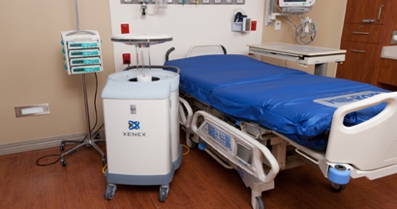 Cleanzine: your weekly cleaning and hygiene industry newsletter 25th April 2024 Issue no. 1111
Cleanzine: your weekly cleaning and hygiene industry newsletter 25th April 2024 Issue no. 1111
Your industry news - first
The original and best - for over 20 years!
We strongly recommend viewing Cleanzine full size in your web browser. Click our masthead above to visit our website version.
Lancaster General Hospital (US) adds Xenex's germ-zapping robot to fight superbugs
 Lancaster General Hospital's newest weapon against hospital-acquired infections looks a little like R2-D2 from Star Wars. The new Xenex room disinfecting system uses ultraviolet (UV-C) light that is 25,000 times more powerful than the sun to 'zap' nasty organisms that cause infections like the flu, norovirus, MRSA and Clostridium difficile (C. diff). In minutes, the device can disinfect a patient room, patient bathroom or operating room (OR) by pulsing the light, which washes over the surfaces where germs reside.
Lancaster General Hospital's newest weapon against hospital-acquired infections looks a little like R2-D2 from Star Wars. The new Xenex room disinfecting system uses ultraviolet (UV-C) light that is 25,000 times more powerful than the sun to 'zap' nasty organisms that cause infections like the flu, norovirus, MRSA and Clostridium difficile (C. diff). In minutes, the device can disinfect a patient room, patient bathroom or operating room (OR) by pulsing the light, which washes over the surfaces where germs reside.
LGH is the fourth hospital in Pennsylvania to have the Xenex device. About 100 hospitals nationwide are using the system, aimed at reducing rates of infection and saving costs. And it's safe. Because the light is extremely intense, the machine operates on its own once it's set up in a room. A sign placed outside the door warns people not to enter, and a motion sensor automatically shuts off the machine if someone should enter.
According to Scott Garrety, director of Environmental Services for LGH, three Xenex machines are being used in the operating rooms, isolation rooms and Intensive Care and Trauma-Neuro Units after every discharge or transfer.
"This technology is used in high risk areas in conjunction with the extensive cleaning services already provided by our Environmental Services team," he says. "As the public health crisis of the 2013 flu season demonstrates, the most critical step to ensure infection control begins with a clean environment. In the past three weeks Xenex has sanitised 711 of our patient rooms."
After cleaning, housekeepers position the Xenex device on both sides of the bed and in the washroom to further disinfect 99.99 percent of dangerous contaminants. Each treatment takes about five minutes, or 15 minutes per room.
Deb Hess, RN, CIC, Supervisor of Epidemiology, who first learned about Xenex Healthcare Services at a conference last year, and then shared with colleagues at LG Health, says: "We already have a strong infection prevention programme. The Xenex technology allows us to be even more proactive in protecting the health of our patients and staff.
"In addition to offering better protection to patients, Xenex is also anticipated to save the hospital approximately $1 million a year as it reduces the incidence of hospital acquired infections."
LG Health hopes to roll out Xenex systems at Women & Babies Hospital and in more locations at LGH in the near future.
18th April 2013







